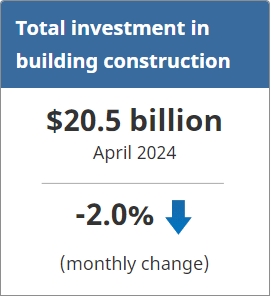Statistics Canada: Investment in Building Construction, April 2024

Investment in building construction decreased 2.0% to $20.5 billion in April compared with March. The residential sector declined 2.7% to $14.2 billion, while the non-residential sector fell 0.5% to $6.3 billion.
On a constant dollar basis (2017=100), investment in building construction decreased 1.9% to $12.6 billion in April.
Investment in residential sector declines
Investment in residential building construction decreased by $386.7 million (-2.7%) to $14.2 billion in April. Monthly declines were recorded in 9 of the 13 provinces and territories in April, led by Ontario (-$123.9 million to $5.5 billion) and Alberta (-$118.4 million to $1.7 billion). These declines were tempered by increases in the remaining provinces and territories, led by Saskatchewan (+$33.7 million to $287.1 million).
Across Canada, single family home investment fell 4.7% to $6.9 billion in April. Saskatchewan (+17.7%; +$29.8 million) was the only province to report an increase in single family home investment in the month.
Multi-unit family investment was down 0.6% to $7.3 billion in April. Decreases were observed in six provinces and one territory. Much of the decline was offset by gains in Nova Scotia (+10.5%; +$17.6 million) and Quebec (+1.1%; +$14.1 million).
Non-residential construction investment edges down
Investment in non-residential construction edged down by $31.2 million (-0.5%) to $6.3 billion in April. Declines in the industrial (-1.4%; -$19.5 million) and commercial (-0.7%; -$23.2 million) components were partially offset by a slight increase in the institutional component (+0.6%; +$11.4 million) in the month.
In April, 7 of the 13 provinces and territories reported gains in institutional construction investment, with Manitoba (+10.2%; +$7.4 million) leading the way. Notably, this was the 15th consecutive monthly increase for Manitoba. On a year-over-year basis, the value of institutional construction investment in Manitoba nearly doubled, from $40.0 million in April 2023 to $79.8 million in April 2024.
For more information on construction, please visit the Construction statistics portal.
For more information on housing, please visit the Housing statistics portal.
Note to readers
Table 34-10-0175 has been archived on the Statistics Canada website and will no longer be updated but may still be viewed. The successor table is 34-10-0286, and the information from January 2017 onwards that was in table 34-10-0175 is still available in the new table, except for the constant dollar series, which have been rebased to 2017=100. Constant dollar data for January and February 2017 represent an average between the old base year (2012=100) and the new base year (2017=100) and should be used with caution. These 2017 data series will be backcasted and the figures will be revised with the release of our annual revision.
Data are subject to revisions based on late responses, delayed construction start dates for large projects, methodological changes, classification updates, price index updates for constant dollar series, benchmarking, and adjustments to ad hoc macroeconomic events. Unadjusted data have been revised back to January 2023. Seasonally adjusted data have been revised back to January 2017.
Data presented in this release are seasonally adjusted with current dollar values unless otherwise stated. Using seasonally adjusted data allows month-to-month and quarter-to-quarter comparisons by removing the effects of seasonal variations. For information on seasonal adjustment, see Seasonally adjusted data – Frequently asked questions.
Monthly estimates for constant dollars are calculated using quarterly deflators from the Building Construction Price Index (18-10-0276-01). The monthly indexes used for the deflation process were part of a methodology review to increase the quality of the constant dollar and seasonally adjusted series. The indexes previously displayed a step pattern due to less frequent collection.
Detailed data on investment activity by type of building and type of work are now available in the unadjusted current dollar series.
The trade and services subcomponent includes buildings such as retail and wholesale outlets, retail complexes and motor vehicle show rooms. More detailed information can be found on the Integrated Metadatabase at Types of Building Structure – 2.2.1 – Trade and services.
Next release
Data on investment in building construction for May will be released on July 18.
Products
Statistics Canada has a “Housing Market Indicators” dashboard. This web application provides access to key housing market indicators for Canada, by province and census metropolitan area. These indicators are automatically updated with new information from monthly releases, giving users access to the latest data.
Source: Statistics Canada


